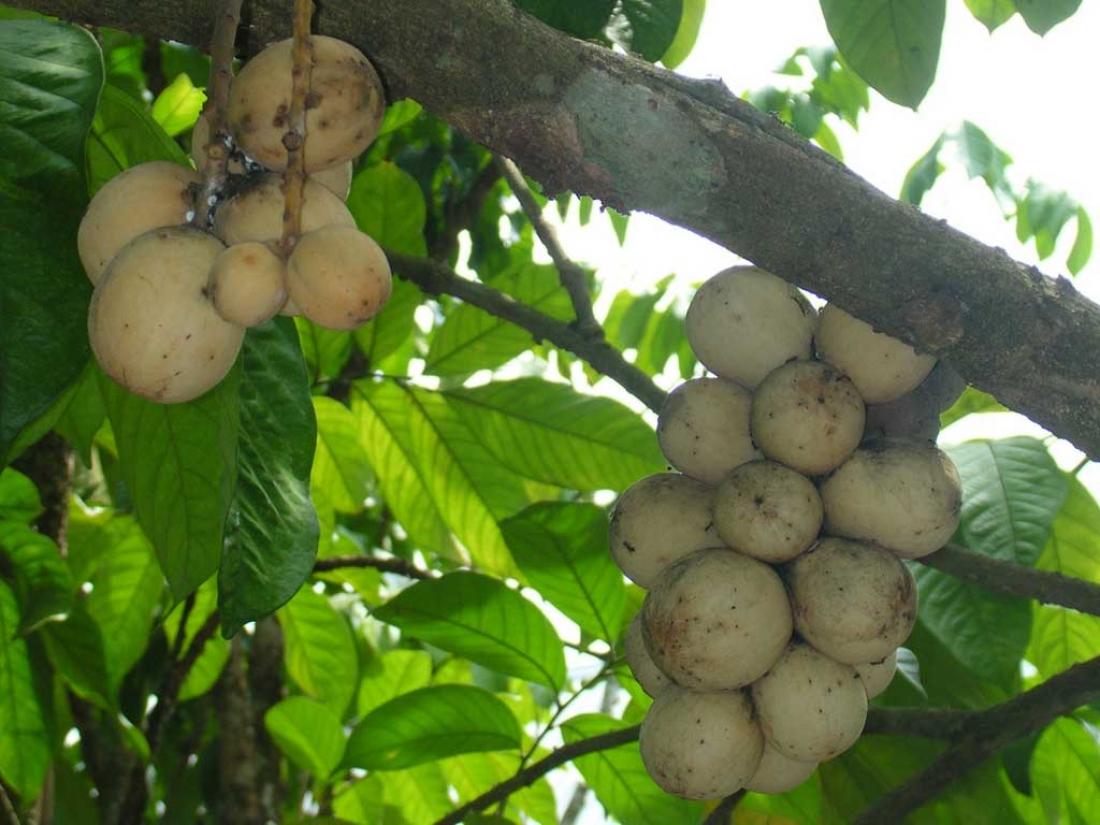Fruit tree bearing bunch of ripe langsat. (Mike Gonzalez/Wikimedia/CC)
Langsat (Lansium domesticum) is a tropical fruit that is commonly cultivated in Southeast Asia. The fruit is rich in fibre, vitamins and minerals, while the peel of langsat contains phenolics and carotenoids, and is traditionally used as an anti-diarrhoea medicine. Anti-oxidative components found in medicinal fruits such as langsat are natural alternatives to synthetic antioxidants (such as butylated hydroxytoluene and tertiary butylhydroquinone), which are added to food as preservatives despite being potentially carcinogenic. Past research has shown that some tropical fruits have higher antioxidant activity in their peel than in their pulp, but the literature on the presence of antioxidant in the peel of langsat has been scarce in Malaysia.
In a paper published in the Pertanika Journal of Tropical Agricultural Science, a research team from UCSI University and the Universiti Putra Malaysia in Malaysia evaluated the total phenolic content (phenols are anti-oxidative compounds) and antioxidant activity of langsat peel extract and peel extract fractions of langsat fruit. Their aim was to determine whether langsat peel has potential for the development of natural antioxidants, and whether fractionation is a suitable method for extracting these compounds.
The researchers found that the total phenolic content of langsat peel extract was up to four times higher than each of the extract fractions, while there was no significant difference among the extract fractions. Similarly, the peel extract also showed the highest antioxidant activity. The team concluded that langsat peel has antioxidant components that are ideal for developing nutraceuticals without fractionation. The researchers also recommended further studies to help identify the structure of the phenolic compounds found in langsat peel.
For more information about each research, please contact:
Asst. Prof. Dr. Yim Hip Seng
Department of Food Science and Nutrition
Faculty of Applied Science
UCSI University
No. 1, Jalan Menara Gading, UCSI Heights
56000 Kuala Lumpur, Malaysia
Email: [email protected]
Tel: +(603) 9101 8880; Mobile: +(6012) 3758776
About Pertanika Journal of Tropical Agricultural Science (JTAS)
Pertanika Journal of Tropical Agricultural Science (JTAS) is published by Universiti Putra Malaysia in English and is open to authors around the world regardless of nationality. The journal is published four times a year in February, May, August and November. Other Pertanika series include Pertanika Journal of Science & Technology (JST), and Pertanika Journal of Social Sciences & Humanities (JSSH).
JTAS aims to provide a forum for high quality research related to tropical agricultural research. Areas relevant to the scope of the journal include: agricultural biotechnology, biochemistry, biology, ecology, fisheries, forestry, food sciences, entomology, genetics, microbiology, pathology and management, physiology, plant and animal sciences, production of plants and animals of economic importance, and veterinary medicine. The journal publishes original academic articles dealing with research on issues of worldwide relevance.
Website: http://www.pertanika.upm.edu.my/
The papers are available from these links:
http://www.pertanika.upm.edu.my/Pertanika%20PAPERS/JTAS%20Vol.%2038%20(1)%20Feb.%202015/09%20Page%20103-112%20(JTAS%200597-2014).pdf
For more information about the journal, contact:
The Chief Executive Editor (UPM Journals)
Head, Journal Division, UPM Press
Office of the Deputy Vice Chancellor (R&I)
IDEA Tower 2, UPM-MDTC Technology Centre
Universiti Putra Malaysia
43400 Serdang, Selangor
Malaysia.
Phone: +(603) 8947 1622 | +(6016) 217 4050
Email: [email protected]
Date of Release: 7 July 2015
Acknowledgements
The Chief Executive Editor, UPM Journals



